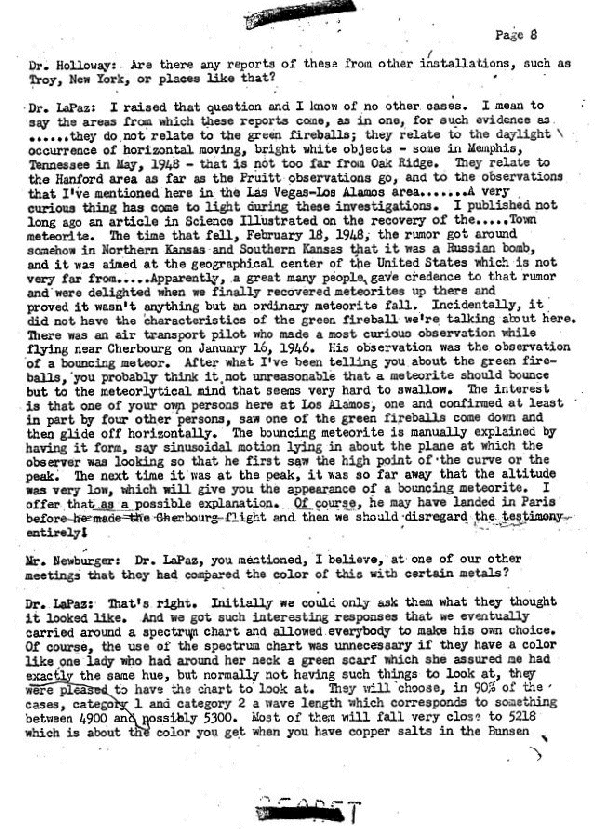This is one of the 24 pages of one of the many formerly secret official documents on this issue. These pages are the minutes of an important conference on the issue held at Los Alamos on February 16, 1949. Representatives of the Army, the FBI, the Air Force and scientists joined together. Dr. La Paz spent two years chasing the green fireballs and explains the issues. Dr. Edward Teller, one of the fathers of the atomic bomb, asks questions.
1 2 3 4 5 6 7 8 9 10 11 12 13 14 15 16 17 18 19 20 21 22 23 24

|
Dr. Holloway: Are there any reports of these from other installations, such as Troy, New York, or places like that?
Dr. LaPaz: I raised that question and I know of no other cases. I mean to say the areas from which these reports come, as in one, for such evidence as ... they do not relate to the green fireballs; they relate to the daylight occurrences of horizontal moving, bright white objects - some in Memphis, Tennessee in May, 1948 - that is not too far from Oak Ridge. They relate to the Hanford area as far as the Pruitt observation go, and to the observation that I've mentioned here in the Las Vegas-Los Alamos area ... A very curious thing has come to light during these investigations. I published not long ago an article in Science Illustrated on the recovery of the ... Town meteorite. The time that fall, February 18, 1948, the rumour got around somehow in Northern Kansas and Southern Kansas that it was a Russian bomb, and it was aimed at the geographical center of the United States which is not very far from ... apparently, a great many people gave credence to that rumour and were delighted when we finally recovered meteorites up there and proved it wasn't anything but an ordinary meteorite fall. Incidentally, it did not have the characteristics of the green fireball we're talking about here. There was an air transport pilot who made a most curious observation while flying near Cherbourg on January 16, 1946. His observation was the observation of a bouncing meteor. After what I've been telling you about the green fireballs, you probably think it's not reasonable that a meteorite should bounce but to the meteorlytical mind that seems very hard to swallow. The interest is that one of our own persons here at Los Alamos, one and confirmed at least in part by four other persons, saw one of the green fireballs come down and then glide off horizontally. The bouncing meteorite is manually explained by having it form, say sinusoidal motion lying in about the plane at which the observer was looking so that he first saw the high point of the curve or the peak. The next time it was at the peak, it was so far away that the altitude was very low, which will give you the appearance of a bouncing meteorite. I offer that as a possible explanation. Of course he may have landed in Paris before he made the Cherbourg flight and then we should disregard the testimony entirely!
Mr. Neuburger: Dr. LaPaz, you mentioned, I believe, at one of our other meetings that they had compared the color of this with certain metals?
Dr. LaPaz: that's right. Initially we could only ask them what they thought it looked like. and we got such interesting responses that we eventually carried around a spectrum chart and allowed everybody to make his own choice. Of course, the use of the spectrum chart was unnecessary if they have a color like one lady who had around her neck a green scarf which she assured me had exactly the same hue, but normally not having such thing to look at, they were pleased to have the chart to look at. They will choose, in 90% of the cases, category 1 and category 2 a wave length which corresponds to something between 4900 and possibly 5300. Most of them will fall very close to 5218 which is about the color you get when you have copper salts in the Bunsen
1 2 3 4 4 6 7 8 9 10 11 12 13 14 15 16 17 18 19 20 21 22 23 24